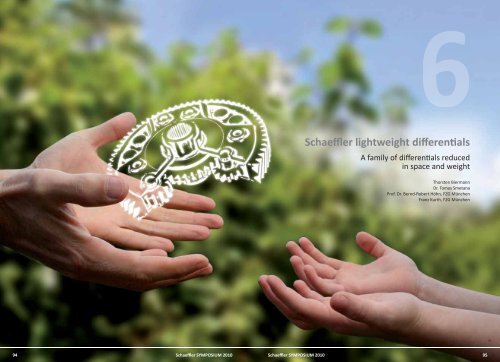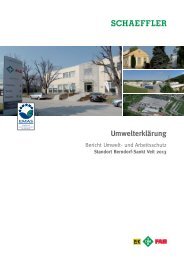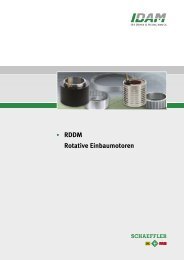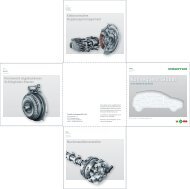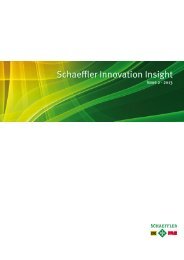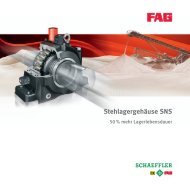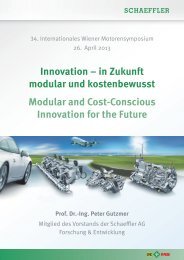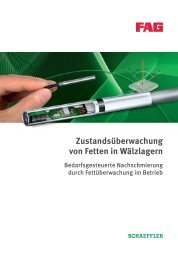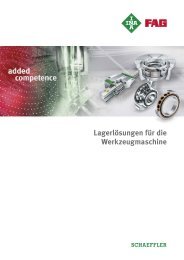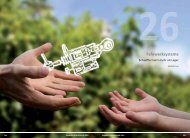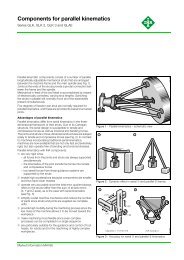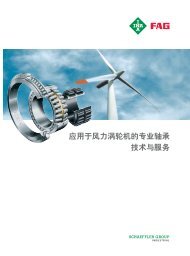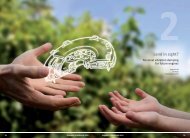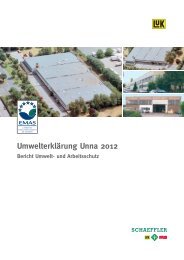6 - Schaeffler Group
6 - Schaeffler Group
6 - Schaeffler Group
Create successful ePaper yourself
Turn your PDF publications into a flip-book with our unique Google optimized e-Paper software.
6 Lightweight diff erenti als<br />
6 Lightweight diff erenti als<br />
Lightweight diff erenti als<br />
Schaeffl er lightweight diff erenti als<br />
A family of diff erenti als reduced<br />
in space and weight<br />
Thorsten Biermann<br />
Dr. Tomas Smetana<br />
Prof. Dr. Bernd-Robert Höhn, FZG München<br />
Franz Kurth, FZG München<br />
94<br />
Schaeffl er SYMPOSIUM 2010<br />
Schaeffl er SYMPOSIUM 2010<br />
95<br />
6<br />
6
6 Lightweight diff erenti als<br />
Preface<br />
In addition to improving the efficiency of individual<br />
drive train components and making energy<br />
conversion more efficient, reducing the<br />
weight of a transmission is essential for saving<br />
fuel while improving driving dynamics. Considerable<br />
success in weight reduction has been<br />
achieved in the past by using more efficient materials,<br />
but no major improvements have been<br />
made in differential technology. The most common<br />
axle differential design continues to be a<br />
bevel gear differential. Due to the high component<br />
loads, this design does not allow weight<br />
reductions by replacing materials.<br />
<strong>Schaeffler</strong>’s lightweight differential offers a solution<br />
that combines low weight and cost efficiency<br />
with remarkable design space reduction. This<br />
move away from conventional bevel gear differential<br />
designs toward spur gear differentials provides<br />
opportunities for integrating innovative<br />
design ideas and state-of-the-art manufacturing<br />
technology.<br />
This paper discusses of the possibilities of lightweight<br />
differentials, beginning with a description<br />
of the design and the function of these differentials.<br />
This is followed by a comparison with<br />
conventional bevel gear differentials, specifically<br />
with regard to weight and space reduction for<br />
various torque classes.<br />
Introducti on<br />
History<br />
The present developments are based on a research<br />
project that was initiated by the FZG Munich<br />
in 2002. The purpose of the research project<br />
was to develop a spur gear differential that is<br />
more compact and lighter than conventional<br />
bevel gear differentials (see Figure 1).<br />
Industry partners in the project were General<br />
Motors Powertrain - Germany GmbH in Rüsselsheim<br />
and <strong>Schaeffler</strong> KG in Herzogenaurach.<br />
During the project, Prof. Dr.-Ing. Bernd-Robert<br />
Höhn of FZG Munich supervised the setup and<br />
testing of prototypes on test stands and in vehicles<br />
[4].<br />
Figure 1 Spur gear diff erenti al by FZG Munich<br />
Successful vehicle tests with this first spur gear<br />
differential led <strong>Schaeffler</strong> to continue its development<br />
work with the goal of offering a solution<br />
for large-volume production.<br />
In this new differential design, the main focus<br />
was initially on manufacturing aspects and on<br />
the optimization of production costs while allowing<br />
for greater design space requirements<br />
compared to the spur gear differential developed<br />
by FZG. However, now that some development<br />
cycles have been completed, this differential<br />
designed for large-volume production is<br />
on a par with FZG’s original design.<br />
Besides new gear teeth designs that were developed<br />
in cooperation with FZG, the consistent<br />
use of <strong>Schaeffler</strong>’s core expertise for cold-forming<br />
sheet steel played a major role because its<br />
design and structure ensures a high level of rigidity<br />
for the differential housing. The housing<br />
design was developed based on current planet<br />
carriers in conventional automatic transmissions<br />
that use similar technologies. Their design<br />
was optimized in the past to further increase<br />
the power density of the relevant<br />
transmissions.<br />
State of the art<br />
As mentioned at the start, bevel gear differentials<br />
are used in most final drive units in motor<br />
vehicles (see Figure 2). The design of the bevel<br />
gear differential offers flexibility and the opportunity<br />
of combining different drive gears.<br />
On a front-wheel drive vehicle with an engine<br />
mounted transversely at the front, the drive is<br />
introduced via a spur gear, which transfers the<br />
torque to the differential cage. On rear-wheel<br />
drive vehicles or vehicles with front-wheel<br />
drive and an engine mounted longitudinally at<br />
the front, a hypoid gear is usually used instead<br />
of a spur gear. The differential cage transmits<br />
the torque to a pinion shaft on which the differential<br />
pinions are mounted. These differential<br />
pinions, together with the axle drive bevel<br />
gears, form the gear teeth of the differential.<br />
There are two gear teeth contacts in the flow of<br />
force from axle to axle with a stationary gear<br />
ratio of i = -1. 0<br />
Torque is distributed via the differential pinions<br />
to both axle drive bevel gears. Two differential<br />
pinions are normally used. The differential cage<br />
is usually a single-piece, solid cast design. Openings<br />
in the differential cage enable the differential<br />
pinions and the axle drive bevel gears to be<br />
assembled from the side. It is possible to increase<br />
the number of differential pinions in order<br />
to enable the transmission of higher axle<br />
torques. The loads in<br />
the individual tooth<br />
contacts are reduced<br />
by these measures.<br />
The differential pinions<br />
and axle drive<br />
bevel gears are arranged<br />
spatially in a<br />
spherical housing. The<br />
contact surfaces between<br />
the bevel gears<br />
and the housing are<br />
also usually spherical.<br />
In most applications,<br />
the axle drive bevel<br />
gears and differential<br />
pinions are manufactured<br />
as forgings in a<br />
tolerance range of IT9<br />
to 11.<br />
Lightweight diff erenti als<br />
Figure 2 Standard fi nal drive with bevel gear<br />
diff erenti al<br />
Spur gear<br />
diff erenti al by FZG<br />
Concept<br />
The spur gear differential concept is at least as<br />
old as the bevel gear differential. The author<br />
has, amongst other things, an extract from a<br />
specialist American book with the title “Self-<br />
Propelled Vehicles” from 1911, which contains<br />
Figure 3 Exploded view of the spur gear diff erenti al by FZG<br />
96 Schaeffl er SYMPOSIUM 2010<br />
Schaeffl er SYMPOSIUM 2010 97<br />
6<br />
6
6 Lightweight diff erenti als<br />
1<br />
5 6<br />
a detailed report about spur gear differentials<br />
[1].<br />
According to Müller [2], the spur gear differential<br />
concept by FZG is a reversing transmission<br />
with a stationary gear ratio i = -1. The torque is<br />
0<br />
introduced via the drive gear (1) and a center bar<br />
(2) on which pinions or planet gears (3, 4) are<br />
arranged in pairs.<br />
The pinions (3, 4) of a pair mesh with each other<br />
across part of their gear tooth width. One<br />
pinion (3, 4) of each pair is also geared with the<br />
left, internal-geared output wheel (5); the other<br />
is geared with the right, internal-geared output<br />
wheel (6). The objective of this arrangement<br />
is to minimize the loads in the gear teeth<br />
contact, especially the tooth flank pressures<br />
between the pinion and the internal-geared<br />
wheel, by a suitable pairing of the internal and<br />
external gear teeth. Furthermore, the point of<br />
contact between internal-geared wheels (5, 6)<br />
and planets (3, 4) is on a larger pitch circle compared<br />
to other differential designs, which leads<br />
to lower circumferential forces in the differential<br />
gear teeth [3] for the same total wheel<br />
torque.<br />
2<br />
3 4<br />
Figure 4 Transmission diagram of FZG spur gear<br />
diff erenti al<br />
Advantages of the compact<br />
diff erenti al design<br />
The lower gear teeth forces compared to a bevel<br />
gear differential enable an extremely narrow<br />
gear teeth contact, which allows the design<br />
space and weight to be reduced compared with<br />
a bevel gear differential. According to Heizenröther<br />
[3], the reduction in weight is approximately<br />
17 % compared with a conventional bevel<br />
gear differential. The possibilities resulting from<br />
the reduction in the spacing between the semilocating<br />
bearings are also of interest. Normally,<br />
the design space of the differential infringes the<br />
clutch housing space. The radial dimensions of<br />
the clutch are only limited by the differential<br />
housing. This leads to problems especially with<br />
two-shaft transmissions if additional design<br />
space is required for the clutch. An increase in<br />
the length of the transmission is then often unavoidable.<br />
Double clutch transmissions are currently presenting<br />
engineers with new challenges. The design<br />
space required by the clutch system is also<br />
making engineers rack their brains here, too.<br />
Particularly as the performance capability of<br />
these new transmissions depends significantly<br />
on the clutch.<br />
Further areas of application can be developed<br />
from integrating additional functions in the spur<br />
gear differential, for example, switchable accessory<br />
drives or also center differentials. In this<br />
way, standard transmissions can be equipped<br />
with additional functions relatively cost effectively<br />
and contribute to more efficient design of<br />
the drive train.<br />
Ultimately, at least part of the gained design<br />
space can be used for optimizing the bearing positions.<br />
The reduced bearing spacing has not<br />
proven to be a disadvantage here. On the contrary,<br />
the thermal influence on the bearing position<br />
is reduced because thermal expansion of<br />
the transmission housing has a correspondingly<br />
reduced effect on the bearing position. In addition,<br />
the decisive portion of the radial force is<br />
transferred in almost equal parts to the main<br />
bearings. This fact enables a reduction of the<br />
preload and replacement of the tapered roller<br />
bearings previously used by more efficient ball<br />
bearings which have lower friction.<br />
Schaeffl er lightweight<br />
diff erenti al<br />
Concept<br />
The prototype of the FZG differential is certainly<br />
a milestone with regard to its design space requirements<br />
and weight. It does have a design<br />
disadvantage that can only be compensated by<br />
an extremely narrow gear teeth width. Employing<br />
internal-geared wheels on the axle drive<br />
makes it impossible to mount the differential<br />
planets in the housing. An additional center bar<br />
must be inserted that serves as the planet carrier.<br />
The sheet steel housing is only needed to<br />
support the final drive gear (1). Torques are not<br />
transmitted.<br />
The idea behind the lightweight differential developed<br />
by <strong>Schaeffler</strong> here is to eliminate the<br />
Lightweight diff erenti als<br />
center bar and mount the pinions (3, 4) in the<br />
housing (2). This only works if the design does<br />
not include an output with internal-geared<br />
wheels and uses classic suns (5, 6) instead.<br />
From a manufacturing technology standpoint, this<br />
can lead to cost savings over the original FZG design<br />
since one less component is required and the<br />
low weight of the suns (5, 6) makes them less expensive<br />
to produce than the internal-geared<br />
wheels.<br />
In terms of the design, the differential planets<br />
(3, 4) can be arranged on a relatively large pitch<br />
circle diameter, which reduces the forces in the<br />
gear teeth contact between the differential<br />
planets. However, the actual innovation of this<br />
<strong>Schaeffler</strong> design is not in the concept shown<br />
here, but rather in the various gear teeth variants<br />
that have been developed since.<br />
Gear teeth design in<br />
Schaeffl er’s lightweight<br />
diff erenti als<br />
<strong>Schaeffler</strong> selected a Volkswagen transmission<br />
as the test carrier in the lightweight differential<br />
advance development project. A manual sixspeed<br />
transmission with the designation MQ350<br />
was selected for the first prototype.<br />
The transmission architecture consists of a triple-shaft<br />
transmission with a front transverse<br />
design. This unit was designed for input torques<br />
of up to 350 Nm and is typically used in vehicles<br />
with more powerful engines produced by the<br />
Volkswagen <strong>Group</strong>.<br />
For the transmission of first gear, an axle torque<br />
of up to 5500 Nm is theoretically possible for a<br />
maximum transmission input torque. This torque<br />
was used as the basis for designing the gear<br />
teeth even though the slip limit is much lower<br />
and was assumed to be in a range of approximately<br />
3000 Nm.<br />
Figure 6 shows a cross-section of the MQ350. In<br />
triple-shaft transmissions, the clutch design<br />
space is not limited as much by the differential<br />
as in twin-shaft transmissions. The standard installation<br />
is a final drive with a bevel gear differential,<br />
and the differential cage is riveted to the<br />
final drive gear.<br />
98 Schaeffl er SYMPOSIUM 2010<br />
Schaeffl er SYMPOSIUM 2010 99<br />
1<br />
3 4<br />
5 6<br />
Figure 5 Transmission diagram of Schaeffl er spur<br />
gear diff erenti al<br />
2<br />
6<br />
6
6 Lightweight diff erenti als<br />
Figure 6 VW MQ350<br />
Our lightweight differential also eliminated a<br />
bolted connection using rivets instead. The<br />
weight of the bevel gear differential, including<br />
the final drive gear, is around 9 kilograms. During<br />
development, our goal was to reduce this<br />
weight by at least 15 % and to reduce the design<br />
space so much that the differential bearing seat<br />
is on a plane with the main bearings of the output<br />
shaft.<br />
On the following pages, a distinction is made between<br />
type 1 and type 2 differentials. Figure 7<br />
shows type 1 differential gear teeth. Three planet<br />
differential pairs are arranged on the circumference<br />
of the planetary gear. The number of<br />
planet pairs is irrelevant. Four or five planet<br />
pairs could be used if the surrounding structure<br />
permits, although according to Müller [2] the<br />
following condition for the number of teeth<br />
should be observed:<br />
Z + Z So1 So2 = whole number<br />
ZPP Z So1 and Z So2 are the number of teeth for the output<br />
suns, Z PP is the number of planet pairs on the<br />
circumference. Failure to follow this rule leads to<br />
an uneven distributi on of the planet pairs on the<br />
circumference. The number of teeth of suns ZSo1 and Z are identi cal for axle diff erenti als with the<br />
So2<br />
same torque distributi on.<br />
What is typical for type 1 gear teeth are three<br />
gear teeth areas that are arranged coaxially and<br />
contiguously. In the left and right areas, one<br />
planet of the respective planet pairs meshes<br />
with the relevant output sun. In the center, the<br />
planets mesh with each other. The gear teeth of<br />
the suns have been recessed here.<br />
The drawing also shows that the sun gears and<br />
the planet gears on the left and right of the variant<br />
with helical gear teeth have a mirror-symmetrical<br />
structure, the only distinction being<br />
their spiral direction. The helix angle serves to<br />
increase the differential lock value. In traction<br />
mode, the sun gears contact the housing wall. If<br />
a friction disk is inserted between the sun gears<br />
and the housing wall, the increased friction in<br />
this contact generates the desired locking effect.<br />
The differential behaves similar to a torque-sensor<br />
locking differential in which the differential<br />
lock value for the series is affected by the helix<br />
angle and the friction disk. Resin-bonded friction<br />
Figure 7 Type 1 gear teeth with helix angle > 0°<br />
linings made by Luk Friction are currently being<br />
tested as material for the friction disk in some<br />
prototypes.<br />
Supporting the suns through the housing has<br />
another function-relevant effect. In traction<br />
mode, the differential builds up internal counter<br />
pressure which increases bearing preload.<br />
As a result, the rigidity of the bearing system<br />
varies depending on the torque. This ensures<br />
optimum support of the final drive’s gear teeth<br />
even for high torques. This design reduces the<br />
probability of noise generation.<br />
For all spur gear differentials, the gear teeth of<br />
the existing bevel gear differential were first analyzed.<br />
The maximum tooth root loads and tooth<br />
flank pressures of the differential pinions and<br />
axle drive bevel gears in first gear served as a reference<br />
for designing the gear teeth of the spur<br />
gear differential.<br />
The design of the spur gear differential was not<br />
solely based on loads. Component strength was<br />
also analyzed. However, since both differential<br />
types use comparable, case hardened steel and<br />
the relatively small component sizes are also<br />
similar; many influencing factors that increase<br />
or reduce material rigidity are assumed to be<br />
identical. Other differences in tooth root load<br />
capacity, due to various roughness values, for<br />
instance, were initially neglected because the<br />
focus was on static loads.<br />
Proof of strength for high static loads is provided<br />
on the assumption that they severely damage<br />
the differential components. The calculated<br />
loads are correspondingly high for the tooth<br />
root and the flank. Since the exact load spectrum<br />
is not known and thus cannot be converted<br />
to the load conditions in the spur gear differential<br />
with changed load cycles, a worst case<br />
scenario was assumed. This scenario provides<br />
for the bevel gear differential to be designed<br />
exactly on the border of static strength and fatigue<br />
strength, which would mean that both an<br />
increase in loads and an increase in load cycles<br />
would cause the gear teeth to fail.<br />
The basic idea behind type 2 differentials is<br />
to utilize the axial design space between the<br />
suns of the type 1 differentials, resulting in an<br />
additional narrowing and weight reduction.<br />
This is made possible by moving a sun-planet<br />
tooth contact into the same tooth contact<br />
Lightweight diff erenti als<br />
plane with the planet-planet tooth contact.<br />
Type 1 with three axially arranged tooth contact<br />
planes is thus translated into type 2 differentials<br />
with only two tooth contact planes (Figure<br />
8).<br />
Figure 8 Diagram of gear teeth (type 1 left and type 2<br />
right)<br />
The diagram shows that type 2 differentials can<br />
only be designed asymmetrically. In this design,<br />
one of the suns is smaller than the other sun by<br />
negative profile displacement, which also reduces<br />
the wheel distances of this stage with the<br />
sun. The gear teeth profile of the second sun is<br />
subject to a strong positive displacement,<br />
which results in a large wheel distance. As a<br />
consequence, it is possible to move a sun-planet<br />
tooth contact under the planet-planet tooth<br />
contact. Both gear teeth contacts are thus in<br />
one gear teeth contact plane. All gear wheels<br />
continue to have the same gear teeth module.<br />
To ensure that the torque is distributed evenly<br />
over the two sun gears, both have an identical<br />
number of teeth despite their size difference<br />
(see Figure 9).<br />
An even torque distribution could also be<br />
achieved using a different number of sun teeth<br />
and gear teeth module. In this case, at least one<br />
of the planets would have to have a stepped design<br />
with two different sets of gear teeth, which<br />
has significant production disadvantages com-<br />
100 Schaeffl er SYMPOSIUM 2010<br />
Schaeffl er SYMPOSIUM 2010 101<br />
6<br />
6
6 Lightweight diff erenti als<br />
Figure 9 Type 2 spur gear diff erenti al with straightcut<br />
design<br />
pared to the suggested design. However, in order<br />
to ensure that the differential functions<br />
smoothly, the distance a between the tip circles<br />
of sun 2 and planet 1 would have to be sufficiently<br />
large to prevent these gear teeth from<br />
meshing. This would entail relatively large profile<br />
displacements on the suns.<br />
The size difference between the two sun gears<br />
also leads to a difference in their circumferential<br />
forces, which at first glance contradicts an<br />
even torque distribution. If the rolling circle diameters<br />
of the planets are also considered, as<br />
in Figure 10, the connection becomes clear. As<br />
a result of the different gear teeth parameters<br />
of each gear teeth contact, the planet gears<br />
have two clearly dissimilar rolling circle diameters.<br />
Because of this, the circumferential forces<br />
between the planets and the suns are transmitted<br />
according to the ratio of these two rolling<br />
circle diameters. As a result, the higher circumferential<br />
force impacts the smaller sun gear in<br />
comparison to the larger sun gear, which ultimately<br />
allows an even torque distribution.<br />
Type 1 Type 2<br />
Trac�on mode Trac�on mode<br />
Circumferen�al forces ac�ng on the planets<br />
Circumferen�al forces ac�ng on the suns<br />
Sun 1<br />
Sun 2<br />
Rolling circles in planet/planet tooth contact<br />
Rolling circles in sun/sun tooth contact<br />
Figure 10 Comparison of circumferenti al forces on the gear teeth of diff erenti als type 1 and 2<br />
The challenge with regard to the gear teeth design<br />
is in the load capacity of sun gear 2. Due to<br />
the negative profile displacement of these gear<br />
teeth and the resulting narrow tooth roots, the<br />
load capacity of the tooth root is reduced significantly.<br />
As a consequence, the gear teeth<br />
contact must be designed to be wider than that<br />
between sun 1 and planet 1. This partially compensates<br />
the advantage of utilizing the design<br />
space between the planets. However, in sum<br />
this enables a significant narrowing of the gear<br />
teeth contacts by approximately 30 %, both for<br />
straight-cut variants and variants with helical<br />
gear teeth.<br />
Housing design<br />
Figure 11 shows an assembled fi nal drive manufactured<br />
by Schaeffl er. Cold-formed sheet steel<br />
forms the housing of the diff erenti al and also supports<br />
the fi nal drive gear. The planet pairs are arranged<br />
on a pitch circle diameter that is as large<br />
as possible to minimize the gear teeth forces. For<br />
this reason, the fi nal drive gear is not fully connected<br />
to the diff erenti al housing on the circumference<br />
but only via three fl anges that remained<br />
as material between the planet pairs. When the<br />
rivet connecti on was designed, current riveted fi -<br />
nal drives were used as a reference.<br />
The diff erenti al housing consists of two sheet<br />
steel half cups which can be designed diff erently<br />
from each other depending on the gear teeth design.<br />
For diff erenti al type 1, the two half cups are<br />
designed to be completely identi cal. For type 2<br />
diff erenti als, the base<br />
carriers are identi cal,<br />
but the hole patt ern of<br />
the planet bearings is<br />
arranged in a mirrorinverted<br />
fashion because<br />
of the diff erent<br />
pitch circle diameters<br />
of the planetaries.<br />
Straight-cut type 1 differenti<br />
als have the<br />
largest number of similar<br />
parts. Here, besides<br />
the housing half<br />
cups, all diff erenti al<br />
planets and the suns<br />
are made from similar<br />
components.<br />
Lightweight diff erenti als<br />
Figure 11 Schaeffl er lightweight diff erenti al with<br />
housing<br />
Advantages of the Schaeffl er<br />
lightweight diff erenti al<br />
Figure 12 shows the various gear teeth designs for<br />
type 1 and 2 diff erenti als. The comparison shows<br />
that the axial design space can be reduced further<br />
by type 2 gear teeth.<br />
Generally this means a further reducti on in axial<br />
design space of approx. 17 % between the straightcut<br />
type 1 diff erenti al and the type 2 diff erenti al<br />
with helical gear teeth. The width of the gear teeth<br />
was reduced by 30 %.<br />
Figure 12 Comparison of gear teeth and axial design space of type 1 and 2<br />
diff erenti als with straight-cut and helical gear teeth<br />
102 Schaeffl er SYMPOSIUM 2010<br />
Schaeffl er SYMPOSIUM 2010 103<br />
6<br />
6
6 Lightweight diff erenti als<br />
Comparison<br />
between the<br />
bevel gear<br />
diff erenti al<br />
and the<br />
Schaeffl er<br />
lightweight<br />
diff erenti al<br />
The goal of the project<br />
was to develop a differenti<br />
al whose support<br />
bearings are on a<br />
plane with the main<br />
bearing of the output<br />
shaft , and this goal has<br />
been achieved. The<br />
type 2 diff erenti al<br />
even remains completely<br />
within the design<br />
space width of<br />
the fi nal drive gear so<br />
that collisions with<br />
gear wheels are prevented.<br />
Compared to<br />
the bevel gear diff erenti<br />
al, the savings<br />
shown in Figure 13 are<br />
achieved for the higher<br />
torque class.<br />
Based on the insights<br />
gained, developments<br />
for other differentials<br />
in various<br />
torque classes have<br />
already been initiated.<br />
The tendency in these developments is basically<br />
comparable. Even for transmissions with<br />
lower torque capacity, benefits of a similar<br />
magnitude are achieved. Among other things, a<br />
design for a transmission with maximum axle<br />
torque of 2100 Nm has been prepared to evaluate<br />
the efficiency of the <strong>Schaeffler</strong> design. Figure<br />
14 shows a compilation of the results.<br />
Figure 13 Weight and design space savings for 5500 Nm axle torque<br />
Figure 14 Weight and design space savings for 2100 Nm axle torque<br />
Summary<br />
The successful development of the Schaeffl er<br />
lightweight diff erenti al, is a development which<br />
many experts had not expected for a 100-year old<br />
product. The actual basic idea of locati ng the<br />
planets as far outboard as possible, and thereby<br />
accepti ng a weakening of the fi nal drive gear in<br />
the process, borders on negligence. Alongside the<br />
predicted problems relati ng to manufacturing<br />
and functi on, excessive noise emissions from the<br />
fi nal drive gear were also expected.<br />
The results that are now available are all the more<br />
pleasing. The lightweight diff erenti al by Schaeffl er<br />
has shown that it is extremely robust and quiet,<br />
both during the acousti c test and also during the<br />
rati ng life tests.<br />
The current level of development indicates that despite<br />
inferior manufacturing tolerances and greater<br />
out of roundness of the fi nal drive gear, the<br />
noise level of the spur gear diff erenti al is as much<br />
as 10 dB under the noise level of a comparable<br />
bevel gear diff erenti al. The acousti c test was carried<br />
out at AFT in Werdohl (Germany).<br />
These fi ndings indicate that the spur gear diff erenti<br />
al in its current development level not only has an<br />
enormous potenti al compared with the bevel gear<br />
diff erenti al, but also compared with diff erent Torsen<br />
concepts. Due to the large number of similar<br />
parts, straight-cut type 1 diff erenti als are intended<br />
for producti on in smaller quanti ti es and to cover<br />
the range of functi ons of bevel gear diff erenti als.<br />
Type 2 diff erenti als with helical gear teeth necessitate<br />
large producti on quanti ti es due to the diff erent<br />
planets, suns and housing halves, and the design<br />
which is based on manufacturing technology<br />
using forming methods. The diff erenti al lock value,<br />
which is increased by suitable helix angles and fricti<br />
on disks, also off ers an alternati ve to diff erent,<br />
mechanical Torsen diff erenti als.<br />
The design space, which is signifi cantly reduced<br />
compared with a bevel gear diff erenti al, also enables<br />
the integrati on of additi onal functi ons, which<br />
could not be previously provided in transmissions<br />
mounted in a front transverse arrangement.<br />
Schaeffl er has already initi ated development for a<br />
Lightweight diff erenti als<br />
switchable rear axle output or also integrated center<br />
diff erenti als. Type 2 diff erenti als are also an essenti<br />
al component of an electric axle described in a<br />
further presentati on [6].<br />
All in all, the presence of the lightweight diff erenti<br />
al on the market can only increase in view of increasing<br />
energy and raw material prices or procurement<br />
problems and based purely on cost<br />
considerati ons.<br />
Literature<br />
[1] Homans, James E.: Self-Propelled Vehicles,<br />
Theo. Audel & Company, New York, 1911<br />
[2] Müller, H.W.: Die Umlaufgetriebe (Auslegung<br />
und vielseiti ge Anwendungen), 2. Auflage,<br />
Springer- Verlag, Berlin Heidelberg,<br />
1998<br />
[3] Heizenröther, M.: Entwicklung eines<br />
Stirnraddifferenzials mit Innenverzahnung<br />
in Blechbauweise, Abschlussbericht<br />
zum Forschungsvorhaben P546 der<br />
[4]<br />
Forschungsvereinigung Stahlanwendung<br />
e.V. (FOSTA), 2005<br />
Höhn, Bernd-R., Michaelis, K., Heizenröther,<br />
M.: Kompaktes Achsgetriebe für<br />
Fahrzeuge mit Frontantrieb und quer<br />
eingebautem Motor, ATZ 1/2006<br />
[5] Niemann, G.; Winter, H.; Höhn, B.-R.:<br />
Maschinenelemente Band II, Springer-Verlag<br />
Berlin Heidelberg, 2003<br />
[6] Smetana, T.; Biermann, T.; Höhn, B.-R.;<br />
Kurth, F.: Schaeffl er acti ve eDiff erenti al –<br />
The acti ve diff erenti al for future drive<br />
trains: 9. Schaeffl er Symposium, 2010<br />
104 Schaeffl er SYMPOSIUM 2010<br />
Schaeffl er SYMPOSIUM 2010 105<br />
6<br />
6


